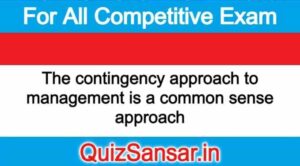
The contingency approach to management is a common sense approach
The contingency approach to management is an important perospective in modern management thought. Among the important contributors to this view of management are Joan Woodward, Lawrence Pugh, Hickson and Mintzberg. The main motto of the Contingency School is, “it all depend.”
Contingency approach to management is based on the assumption that the methods, techniques and prescriptions suggested by the various schools of management cannot consistently work and be effective in every situation. It suggests that the effectiveness of various management practices, styles, techniques and functions will vary depending on the particular facts and circumstances of each situation. Important Elements of Contingency Theory Contingency theory has the following features:
1. Managerial actions are contingent on certain actions outside the system or subsystem as the case may be.
2. Organisational efforts should be based on the behaviour or actions outside the system so that the organisation gets smoothly integrated with the environment.
3. Managerial actions and organisational design must be appropriate to the given situation. A particular action is valid only under certain conditions. There is no one best approach to management. It varies from situation to situation.
Implications of Contingency Approach
According to the contingency approach, there are no plans, organisation structures, leadership styles or controls that will fit all situations. There are few, if any, universal truths, concepts, and principles that can be applied under all conditions. Instead, every management situation must be approached with the ‘it all depends’ attitude. Managers must find different ways that fit different situations. They must continually address themselves with the question: which method will work best here? For example, in order to improve productivity, classical theorist may prescribe work simplification and additional incentives; the behavioural scientist may recommend job enrichment and democratic participation of the employees in the decision-making process. Instead, a manager trained in the contingency approach may offer a solution that is responsive to the characteristics of the total situation being faced. Organisations Characterised by limited resources, unskilled labour force, limited training opportunities, limited products offered to local markets-work simplification would be the ideal solution. Job enrichment programme would work better if the organisation employs skilled labour force. Managerial action, thus, depends upon circumstances within a given situation. No one best approach will work in all situations. Applying a contingency/situational approach requires that managers diagnose a given situation and adapt to meet the conditions present.
According to Robert Albanese, the strength of contingency approach rests on two points; (i) First, it focuses attention on specific situational factors that influence the appropriateness of one managerial strategy over another, (ii) Second, it highlights the importance to manager of developing skills in situational analysis. Such skells will help managers find out important contingency factors that infuence their approach to managing.
Evaluation
The contingency approach is a useful instructional device in the sense that it compels us to be aware of the complexity in every situation and forces us to take an active and dynamic role in trying to determine what would work best in each case. Combining the mechanistic (Taylor) and humanistic approaches (Mayo) the contingency theory suggests that different conditions and situations require the application of different management techniques. It helps in fitting the classical and behavioural theories in a proper framework. It is an improvement over the systems theory in the sense that it only examines the relationships between substems of a specific organisation in a given environment, but also offers solutions to particular organisational problems. However, this theory is attacked by several theorists on the following grounds:
1. Paucity of Literature: Contingency theory suffers from inadequacy of literature. It has not developed to such an extent where it can offer meaningful solutions to different managerial problems in a specific way. It is too simplistic to say that managerial actions depend on situations. Instead, it must offer, in precise terms, what a manager should do in a given situation.
2. Complex: Contingency theory is theoretically complex. Even a simple problem involves analysing a number of organisational components, each of which have innumerable dimensions.
3. Defies Empirical Testing: The precepts advanced by contingency theorists cannot be put to empirical testing in a concrete way. There are multifarious situational factors to be taken into account while testing the contingency theory.
4. Reactive not Proactive: Contingency theory is also criticised on the ground that it suggests a reactive strategy in coping with environmental complexity. Instead, a proactive strategy is needed where managers would be able to steer the organisation through complex environments with their creative and innovative efforts..
5. Incomplete: Critics argue that the contingency approach does not incorporate all aspects of systems theory, and they hold that it has yet not developed to the point at which it can be considered a true theory- Further, the goal of integrating functional, quantitative, behavioural, and systems approaches in the form of a contingency model may prove to be too difficult to realise because of the incomplete development of the earlier approaches. Critics also ague that there is really not much that is new about the contingency approach. For they point out that even classical theorists like Fayol cautioned that management principles require flexible application.
Inspite of these valid critical expressions, contingency theory holds good at the micro-level, where managers are forced to look into internal as well as external requirements while managing their organisations.






